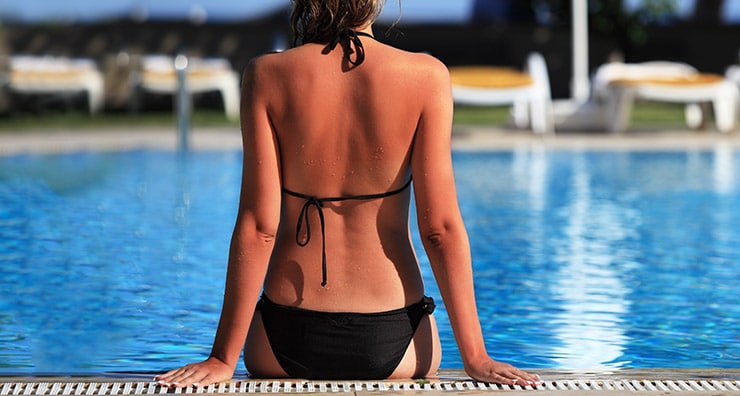
About the Author
Stepha is a copywriter at LovelySkin. She loves poetry, baking and experimenting with new makeup.
Other Posts by StephaWelcome to LovelySkin.com.

Sunburn can lead to skin damage, signs of aging and even cancer, and it goes without saying that it should be avoided at all costs. Sometimes, though, mistakes happen, and after a long day outdoors, you’re left with reddened skin that is hot and painful to the touch. In this LovelySkin blog post, we’ll go over some quick facts about sunburn and list some helpful tips for limiting discomfort and lessening long-term effects.
Sunburns are caused by both UVA and UVB rays. During long periods of sun exposure, skin begins to produce excess melanin, the substance responsible for skin pigment, to protect it from damage. This protection, however, can only go so far toward shielding skin. Tanned skin has an SPF rating between 2 and 4, and eventually, sunburn is inevitable. How soon a person burns depends on skin tone/type, region, time of day and length of time spent outdoors. Because as much as 80% of UV rays penetrate through cloud cover, you can get a sunburn on even cool or overcast days.
The key symptom of a sunburn is red, hot, painful skin that eventually grows itchy and begins to peel and flake. With a severe burn, you may experience swelling, blistering and flu-like symptoms, including fever, headache, nausea and weakness. All sunburns should be treated seriously, even if they appear to be mild. Fortunately, most are mild enough to be addressed at home with these simple steps.
1. First things first: get out of the sun and take ibuprofen.
At the first sign of skin reddening or tingling, go indoors right away and take the recommended dosage of an ibuprofen like Advil. While Tylenol will help alleviate the pain associated with a burn, it does not have the same anti-inflammatory effect as ibuprofen. When you take ibuprofen, you aren’t just addressing symptoms like redness and swelling, you are also helping to prevent long-term skin damage. Continue taking ibuprofen as directed for the next 48 hours and be sure to drink lots of cold water throughout the day to stay hydrated.
Remember that some burns take as long as four to six hours to develop. Check skin carefully at the end of the day for redness, even if you think you’re in the clear, and take ibuprofen if necessary.
2. Take a cool shower or bath.
Taking a cool bath or shower will help regulate an elevated body temperature, and it should work to soothe and comfort skin. If cleansing skin, avoid scrubs and do not use a loofah, washcloth or device, as this could prove irritating and painful. Choose a mild cleanser and use your hands to gently massage skin.
3. Apply a moisturizing product.
Never pick at flaky skin or blisters. A moisturizing gel or lotion can soothe and comfort skin and minimize the appearance of redness and peeling, and formulas that contain aloe vera, vitamin C and vitamin E may be especially nourishing. Be sure to use a lightweight, breathable product and resist over-applying. Heavier creams can act as a barrier, trapping heat in the skin and keeping it red longer. Some of our favorites include LovelySkin Aloe Vera Soothing Skin Relief Gel and derma e Intensive Therapy Body Lotion – Fragrance-Free.
The Skin Cancer Foundation also recommends applying a hydrocortisone product for a day or two after burning to alleviate discomfort. FixMySkin Healing Body Balm Unscented with 1% Hydrocortisone is the perfect on-the-go solution. The heat-resistant, easy-to-use stick contains nourishing and hydrating shea and cocoa butters, plus 1% hydrocortisone to relieve itching, dryness and irritation.
4. Be honest when you assess the damage.
While most sunburns may be treated at home, even if they are accompanied by blisters, there are certain circumstances that require medical attention. If blisters cover more than 20% of the body, seek a physician’s care as soon as possible. Likewise, if you experience a sunburn accompanied by fever and chills, you should see a doctor immediately.
5. Vow to do better next time.
View your sunburn as a learning experience and a way to get to know your skin’s needs. Next time you’re outdoors, you can take more sun safety measures. Consider applying sunscreen more evenly and more frequently, covering up with protective clothing, seeking shade between the hours of 10 a.m. and 4 p.m. and taking Heliocare, a sun protection supplement that can help strengthen skin against damage.
Do you have a question about how to treat sunburn? Let us know on Facebook, Twitter or Instagram using #LovelySkin.
Follow us on social networks and be one of the first to learn about sales, giveaways, and free samples
| Mon - Fri | 9 - 5 p.m. CT |
|---|---|
| Sat (chat only) | 9 - 3 p.m. CT |
| Sun / Holidays | Closed |
| Call or Text: | 402-697-1100 |
|---|